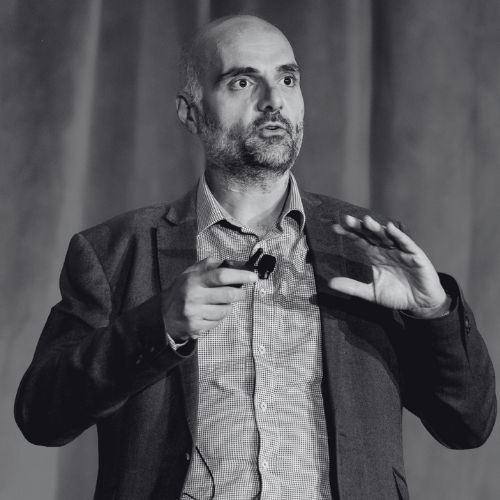Lorem ipsum dolor sit amet, consectetur adipiscing elit. Ut elit tellus, luctus nec ullamcorper mattis, pulvinar dapibus leo.
Lorem ipsum dolor sit amet, consectetur adipiscing elit Lorem ipsum dolor sit amet, consectetur adipiscing elit
Latest news from Packaging Innovations & Empack
Collaboration over chemistry: Why the future of sustainable packaging is human

The real barriers to sustainable packaging aren’t scientific or mechanical; they’re human. Even in an era of robotics, AI, and digitised production lines, collaboration and coordination remain the factors that determine whether innovation succeeds or stalls. Collaboration, not chemistry, will define the next phase of progress.
We’ve reached an extraordinary moment in material science. Every month brings another innovation: fibre-based flexibles that challenge plastic, biopolymers with improved oxygen barrier performance, refill systems that actually work in retail environments. Technically speaking, we’re closer than ever to circularity. And yet, the system still struggles to move as one.
Events like Packaging Innovations & Empack 2026 are vital. They bring together brands, converters, material developers, and recyclers under one roof, offering a rare chance to align perspectives, share breakthroughs, and turn isolated innovations into coordinated action. Real-world collaboration starts at moments like these, where dialogue and hands-on experience transform ideas into scalable solutions.
That’s because materials don’t exist in isolation; people do. Retailers, converters, brand owners, and contract manufacturers often operate in silos, even when they’re all trying to solve the same problem. Each node of the value chain is optimising within its own constraints: procurement teams seek cost stability, converters look for line efficiency, designers chase brand impact, and sustainability leads the push for recyclability. The result? Brilliant intent, fragmented execution.

True progress will come from connection and collaboration, not competition. The most transformative projects aren’t defined by a breakthrough substrate; they’re defined by trust. Joe Muscat, Environmental Stewardship and Innovation Senior Director at Haleon, illustrates this vividly: “We’ve seen enormous progress when you bring together technology, robotics, and packaging expertise. For example, vision-based systems can detect recyclable materials on a line, but it takes collaboration with robotics providers, waste facilities, and other stakeholders to actually make it work at scale.” Technology can exist, but without alignment between people and processes, it cannot scale.
Muscat expands the point beyond the shop floor: “In Europe, brands are working together on trialling digital watermarks on packaging. However, by working across the industry, we can run large-scale trials and generate data that benefit everyone, from producers to consumers. Collaboration adds value in unexpected ways.” The lesson is clear: the more a system enables participants to share knowledge, the more everyone benefits. Fragmented effort may create isolated gains, but collaborative ecosystems produce systemic change.
Mike Wilson, Chief Automation Officer at MTC, reinforces the cross-industry perspective: “We bring together parties from different industries and share learnings so we don’t reinvent the wheel. Collaboration enables knowledge transfer across sectors, making supply chains more effective and resilient. The key is working together to achieve collective success for UK industry.” Wilson’s observation underscores a critical truth: innovation doesn’t exist in a vacuum, and knowledge is a renewable resource. If you multiply it through partnership, the impact compounds.
Emmanuel Ewa of Innovate UK echoes the theme, highlighting the importance of integrating those who will actually use a solution from the start: “We encourage collaboration between those adopting technologies and those developing them. People who benefit from the solution need to be involved from the start and bringing in academic institutions and cross-sector partners ensures the solution works effectively. Collaboration is essential to make a good solution in the end.” Too often, sustainability initiatives falter not because of bad ideas but because they fail to account for the real-world contexts in which they must operate.
Collaboration isn’t just a conceptual ideal; it’s operationally transformative. Wilson explains: “Don’t be afraid of engaging with the supply chain. There are challenges around labour and efficiency, but collaboration enables you to use your people effectively and apply automation where it adds real value. Working with independent partners like MTC helps you build the business case and specifications so that, when you engage with suppliers and technology providers, you’re making informed, collaborative decisions that reduce risk.” The point is subtle but crucial – alignment reduces friction, limits rework and maximises return on investment.

Shared knowledge, shared progress
Transparency is emerging as one of the most powerful enablers of sustainable packaging development. For all the progress in material innovation and recycling infrastructure, it is the ability to truly understand and share what sits inside the system that unlocks its full potential.
As Arno Melchior, former Global Packaging Director at Reckitt, explains: “It’s not enough anymore to know a bottle is made of PET or HDPE. We need to know what makes up the HDPE or PET, what’s in the master batch and what substances it contains. Soon, we’ll need a substance breakdown of our packaging, and that’s where suppliers and their suppliers come in. The whole value chain needs to work together, otherwise we don’t get the data.”
His words underline a growing truth; sustainability no longer resides solely in the physicality of materials, but in the transparency of information. Every stage of the chain, from resin formulation to the filling line, contributes to a data point that determines whether packaging can truly be classed as circular. Without collaboration, those data points remain siloed and progress stalls.
That spirit of shared responsibility is precisely what William Connolly, Senior Principal Scientist at Diageo, sees as defining the next phase of progress. “We have the opportunity to lead this change at scale, but it’s not just about being first,” he says. “We want others to follow quickly. Unlike traditional corporate strategies focused on IP protection, we prioritise industry-wide progress. We share insights with competitors because real change requires collective momentum, not just a competitive edge.”
It is a mindset that runs counter to decades of business orthodoxy, one in which proprietary knowledge was guarded rather than shared. Miguel Arevalo, Head of Packaging Sustainability and Innovation at Google, reinforces this approach: “Google’s approach to packaging is rooted in partnerships – with suppliers, competitors, and industry leaders – to develop holistic solutions that benefit the environment and society. At Google, we believe innovation in sustainability should be a collaborative effort, not a competitive one. We openly share our learnings and insights, empowering companies to develop solutions. It’s not enough to claim something can be done; we believe in demonstrating how solutions are achieved.”
That philosophy of continuous improvement also runs through Greg Bentley’s reflections on craft and culture. “We have a Japanese word we use [at Suntory] ‘Monozukuri’, which describes the craft and mindset of manufacturing,” he says. “To achieve that, you need a passion for it. The theory is important, but you only really internalise it when you get into the nuts and bolts of it and do it yourself. It’s at that point that you can develop new ideas. I keep finding myself saying, ‘right, that’s it, we can’t go any further with this.’ But I think back to 15 years ago, when I thought we couldn’t go any further with lightweighting packaging, but look where we are now. And yet, every time you think ‘that’s it, we can’t do anymore,’ someone else will come along and prove you wrong.”
Bentley’s insight is a fitting close to this thread; progress isn’t a straight line of invention, but an iterative process of learning, sharing, and refining – together. The industry’s next great leaps will come not just from the materials themselves, but from the people who make them possible. Those willing to collaborate across boundaries, share data, align incentives, and view every small gain as part of a collective whole.
Because, in the end, circularity isn’t just a technical system; it’s a human one.

How human networks drive packaging innovation
Collaboration isn’t just a nice-to-have; it’s the engine of innovation. In industries as complex and fast-moving as packaging, breakthroughs in materials or processes only pay off if teams are structured to act on them. Technical solutions, no matter how sophisticated, falter without alignment, trust, and shared accountability across the chain. Few organisations illustrate this better than Amazon, where building the right teams is considered as important as creating the right products.
Johan Hannekom, speaking from experience at Amazon, places collaboration at the centre of innovation: “Within Amazon, the notion is very much that if you have a business opportunity, you should build your dream team to deliver that outcome. These are small, agile teams where each person has autonomy but also takes full ownership of the results. Collaboration isn’t just about working together; it’s about trusting one another to deliver and making sure that everyone’s skills are aligned toward the same goal.” Hannekom’s insight reframes the conversation. Innovation is not a solo endeavour, nor is it merely technical. It’s about creating the conditions for teams to flourish together.
He continues, “True collaboration means empowering teams with the skills, knowledge, and frameworks they need to succeed. It’s not enough to tell people to innovate; they must have the tools, mentorship, and shared understanding to turn vision into results. That’s where co-creation and effective teamwork really come to life.” Sustainability projects succeed not because of directives or decrees but because people can act with confidence, clarity, and accountability.
Tanguy Pellen, Managing Partner at Starbek, reinforces this with a cross-industry perspective: “Innovation thrives when we work together, whether it’s through open innovation or partnerships across industries. Many concepts wouldn’t come to life without cross-industry collaboration. Companies like Diageo are working with partners across sectors to tackle the big societal problems, and with that collaboration, scale can be achieved. It’s about learning from the best, partnering with suppliers, academics, and even competitors. It’s a shift from the old ‘not invented here’ mentality, which is what can stifle innovation and hold companies and even whole sectors back.”
Pellen adds a crucial caveat: innovation without practical end-of-life solutions is hollow. “You don’t want to claim you’ve found a great solution if it’s not recyclable in practice. Ultimately, we need to have a range of solutions that address both the innovation and the end-of-life stage.” This returns us full circle: human coordination is what turns technical possibility into circular reality.
The next era of sustainable packaging will be defined by connectors, those who can bridge the commercial, creative, and operational worlds, ensuring that everyone along the chain can use, process, and profit from the innovation at hand. The materials are ready, the systems exist, and the technology can support them. What remains is the alignment of incentives, the trust between people, and the courage to collaborate.
Because in the end, sustainability is a human network. Like any relationship, it grows stronger when we stop working in parallel and start moving forward together. And as these voices across industry consistently remind us, it’s that human connection, more than any chemistry or engineering feat, that will define the next phase of progress.
Initiatives showcased at Packaging Innovations & Empack 2026 demonstrate this principle in action, with the full supply chain represented, from brand owners and designers to converters, co-packers, fulfilment partners, recyclers, and technology providers. Through cross-industry collaboration, live demonstrations, and hands-on workshops, these gatherings foster collective learning. They remind us that circularity is not just a technical aspiration, but a human endeavour, strengthened every time knowledge is shared face-to-face.
Share this article

Lorem ipsum dolor sit amet, consectetur adipiscing elit Lorem ipsum dolor sit amet, consectetur adipiscing elit
Latest news from Packaging Innovations & Empack
Lorem ipsum dolor sit amet, consectetur adipiscing elit. Ut elit tellus, luctus nec ullamcorper mattis, pulvinar dapibus leo.



